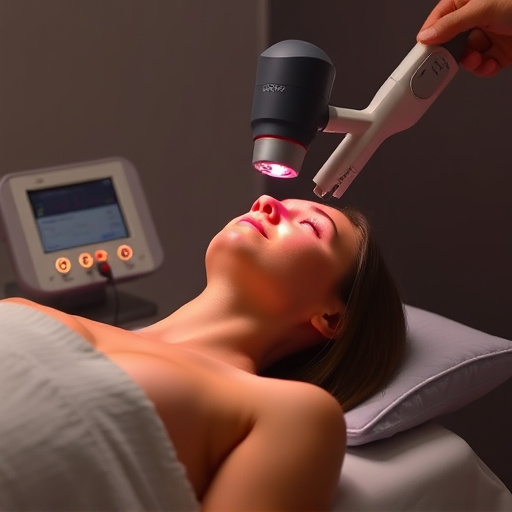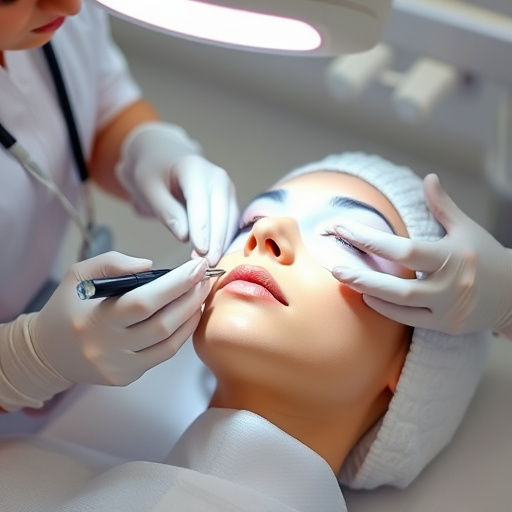Natural Boosts After Comedone Extraction: Clear Skin Secrets
After successful comedone extraction, maintaining healthy skin through natural remedies like facials…….
Comedone extraction, a specialized skin care procedure, has emerged as a pivotal practice in the pursuit of achieving clear, radiant skin. This process involves the meticulous removal of comedones—small plugs or cysts formed within the pores—to prevent and treat acne and related skin conditions. In this comprehensive article, we embark on a journey to unravel the intricacies of comedone extraction, exploring its historical roots, global impact, technological innovations, regulatory frameworks, and its role in shaping the future of skincare. By delving into these aspects, readers will gain an in-depth understanding of why this technique is not just a cosmetic procedure but a significant contribution to dermatology and esthetics.
Comedone extraction, also known as comedo therapy or blackhead removal, is a manual or mechanical process designed to eliminate excess sebum (skin oil) and dead skin cells accumulated within hair follicles, leading to the formation of comedones. These comedones can appear as blackheads or whiteheads on the skin’s surface, depending on whether the pore remains open or gets blocked. The primary goal is to prevent acne breakouts, minimize pore appearance, and restore a healthy, clear complexion.
The procedure involves several core components:
Pore Cleansing: Initially, the skin is thoroughly cleansed to ensure no debris or bacteria are introduced into the pores during extraction.
Identification and Classification: Skilled practitioners visually inspect the skin to identify and classify comedones, determining their size, depth, and location for targeted treatment.
Extraction Techniques: There are various methods employed, including manual pressure, specialized tools (like loop extractors or sterile needles), or mechanical devices that gently suck out the comedones.
Post-Extraction Care: After extraction, proper aftercare is crucial to prevent infections and encourage skin healing. This may include applying calming products, recommending topical treatments, and providing instructions for maintaining optimal skin health.
Historically, comedone extraction has been practiced for centuries, with ancient cultures using natural remedies and tools for blackhead removal. However, it was in the 20th century that significant advancements and standardization occurred, leading to its recognition as a valuable dermatological procedure.
Comedone extraction has transcended geographical boundaries, leaving an indelible mark on skin care routines worldwide. Its impact varies across regions, shaped by cultural preferences, access to technology, and economic factors.
North America and Europe: These regions have witnessed widespread acceptance of comedone extraction as a preventive measure for acne and skincare maintenance. Advanced aesthetic clinics and medical spas offer various extraction techniques, catering to diverse skin types.
Asia Pacific: Countries like Japan, South Korea, and Australia have embraced comedone extraction, often integrating it into traditional skincare routines. The focus here tends to be on achieving a smooth, radiant complexion rather than solely treating acne.
Middle East and Africa: In these regions, access to advanced dermatological treatments varies. Urban areas with higher disposable incomes see an increasing demand for comedone extraction, while remote regions may have limited exposure to such procedures.
Growing Awareness: The rise of social media influencers and celebrities advocating for clear skin has sparked global interest in comedone extraction. Online tutorials and accessible information have democratized skincare knowledge.
Innovative Tools: The market is witnessing a surge in the development of advanced extraction tools, such as LED light therapy devices that combine illumination with extraction, claiming to offer deeper cleansing and improved results.
Personalization: There’s a growing trend towards customized extraction treatments tailored to individual skin types and concerns, emphasizing the importance of personalized skincare.
The economic landscape surrounding comedone extraction is multifaceted, involving various sectors and stakeholders.
Global Market Size: According to a 2022 report by Grand View Research, the global dermatology devices market (which includes comedone extraction tools) is projected to reach USD 14.7 billion by 2030, growing at a CAGR of 8.5% from 2023 to 2030.
Regional Growth: The Asia Pacific region is anticipated to witness the fastest growth due to increasing disposable incomes and rising health awareness. North America and Europe remain significant contributors to the market.
Aesthetic Clinics and Spas: These establishments are major players in the industry, offering a range of skin care services, including comedone extraction. They invest in high-quality extraction tools and equipment to attract and retain clients.
Dermatological Practices: Dermatologists often incorporate comedone extraction into their practices, providing specialized treatments for various skin conditions.
Startup Innovations: Many startups are focusing on developing innovative extraction technologies, attracting investments from venture capital firms and skincare enthusiasts.
Job Creation: The industry contributes to employment in aesthetic clinics, spas, and dermatological practices, creating opportunities for skilled estheticians, nurses, and technicians.
Tourism and Lifestyle: In some regions, comedone extraction has become a tourist attraction, with people traveling for specialized treatments, boosting local economies.
Technology plays a pivotal role in enhancing the precision, effectiveness, and accessibility of comedone extraction. Here’s an overview of some significant advancements:
Loop Extractors: These hand-held tools use a looped wire to gently extract comedones. They are popular due to their simplicity, cost-effectiveness, and ability to target specific areas. Modern versions offer improved comfort and control for practitioners.
Sterile Needles: Precision needle extraction involves inserting sterile needles into the comedones to break them up and facilitate removal. This technique requires skill but offers excellent results, especially for deeper cystic acne.
Suction Devices: Mechanical suction devices use gentle vacuum pressure to extract comedones. They are effective for removing surface blackheads and can be automated for increased efficiency in high-volume clinics.
LED Light Therapy: Combining light therapy with extraction, this approach claims to kill acne-causing bacteria and enhance the effectiveness of extraction. It is non-invasive and may offer additional skin benefits.
AI and Machine Learning: Artificial intelligence is being explored for comedone detection and classification, aiming to assist practitioners in identifying and targeting specific lesions. This technology could improve treatment outcomes and efficiency.
The regulatory environment surrounding comedone extraction varies across jurisdictions, reflecting diverse cultural perspectives and health standards.
Licensing and Certification: In most countries, practitioners performing comedone extraction must be licensed and certified by relevant healthcare authorities. This ensures they meet specific education, training, and safety standards.
Infection Control: Strict guidelines for infection control are in place to prevent the spread of diseases like hepatitis or HIV through improper extraction practices. Sterile tools, proper disposal, and hand hygiene are essential.
Marketing and Advertising: Regulations govern how extraction services can be marketed and advertised to ensure they provide accurate information and avoid misleading claims.
Food and Drug Administration (FDA) Approval: In the United States, certain extraction tools and devices require FDA approval to ensure safety and efficacy. This process involves rigorous testing and evaluation.
International Standards: Organizations like the World Health Organization (WHO) provide guidelines for healthcare practices, including skin care procedures. These standards promote safe and effective medical practices globally.
Despite its growing popularity, comedone extraction faces challenges and criticisms that must be addressed to ensure its effectiveness and ethical practice.
Inconsistent Results: The outcome of extraction can vary significantly depending on the practitioner’s skill, experience, and the complexity of the skin condition. This inconsistency may lead to customer dissatisfaction.
Infection Risks: Improper techniques or non-sterile practices can increase the risk of infections, especially in individuals with compromised immune systems.
Skin Irritation: Some extraction methods, if not performed correctly, can cause temporary skin irritation, redness, or peeling, particularly for sensitive skin types.
Standardization of Training: Developing comprehensive training programs and certifying practitioners can ensure consistent and safe extraction practices across the industry.
Infection Control Measures: Stricter adherence to infection control protocols, including regular equipment sterilization and proper waste disposal, is crucial to mitigate health risks.
Skin Care Education: Educating clients about pre- and post-extraction skin care routines can help manage expectations and reduce potential adverse reactions.
To illustrate the effective application of comedone extraction, let’s explore a few case studies from diverse regions.
Case Study 1: Tokyo, Japan—Integrating Extraction with Skincare Rituals
In Japan, comedone extraction is deeply intertwined with traditional skincare rituals. Many high-end spas offer specialized treatments that combine extraction with other therapeutic practices, such as Japanese herbals and acupressure. This holistic approach has attracted a loyal client base seeking both physical and mental rejuvenation. The success lies in tailoring treatments to individual needs, ensuring extraction is part of a comprehensive skincare journey rather than a one-off procedure.
Case Study 2: Los Angeles, USA—Treating Acne with Advanced Technology
A leading dermatology clinic in LA has pioneered the use of advanced technology in comedone extraction. They employ a combination of AI-assisted diagnosis and innovative suction devices to offer highly precise treatments for cystic acne. By targeting specific lesions and minimizing trauma, they achieve remarkable results while reducing recovery time. This case study highlights how technology can enhance both the effectiveness and patient experience of comedone extraction.
Case Study 3: Sydney, Australia—Community-Based Skin Health Initiatives
In Sydney, a community clinic has implemented comprehensive skin health programs that include comedone extraction for low-income individuals. They offer educational workshops on skincare, combining extraction with personalized product recommendations. This approach not only treats skin conditions but also fosters long-term skin care habits within the community. The success lies in making this specialized service accessible and empowering individuals to take control of their skin health.
The future of comedone extraction is poised for growth, innovation, and increased accessibility.
Personalized Medicine: With advancements in genomics and skincare technology, personalized extraction treatments tailored to an individual’s unique skin profile will likely become more common.
Telemedicine Integration: Remote consultations and virtual extraction guidance could revolutionize access to specialized care, especially in underserved regions.
Sustainability Focus: Eco-friendly extraction tools and practices are expected to gain traction, addressing concerns about waste generation and environmental impact.
Global Expansion: As awareness grows, more regions will witness increased adoption of comedone extraction, leading to a more uniform approach to skincare worldwide.
Regulatory Harmonization: Standardized regulations and guidelines could facilitate the cross-border exchange of extraction technologies and practices, ensuring safety and quality.
Research and Collaboration: Continued research into acne etiology and innovative extraction techniques will drive advancements, improving patient outcomes.
Comedone extraction has emerged as a powerful tool in the skincare arsenal, offering hope and clarity to individuals struggling with acne and related skin conditions. From its historical roots to its global impact, technological innovations, regulatory considerations, and future prospects, this procedure has proven its value in dermatology and esthetics.
As we conclude, it’s evident that comedone extraction is not just a superficial treatment but a significant contribution to achieving healthy, radiant skin. With ongoing advancements and increased accessibility, the future of skincare looks brighter, ensuring that clear, confident skin becomes a reality for many.
Q: Is comedone extraction painful?
A: With proper aftercare and skilled practitioners, extraction can be relatively comfortable. Topical numbing creams or gentle techniques can minimize any discomfort.
Q: How often should I get my comedones extracted?
A: The frequency depends on your skin type, acne severity, and personal goals. For occasional extractions to maintain clear skin, every 4-6 weeks is typically recommended.
Q: Can comedone extraction prevent acne altogether?
A: While it effectively treats existing acne and reduces the appearance of pores, preventing all forms of acne is challenging. Regular extraction can significantly lower the risk, especially when combined with good skincare habits.
Q: Are there at-home comedone extraction tools available?
A: Yes, various at-home kits offer loop extractors or sterile needles for gentle extraction. However, professional guidance is recommended to avoid complications and ensure proper technique.
Q: How do I choose the right practitioner for comedone extraction?
A: Look for licensed and certified estheticians or dermatologists with experience in extraction. Reviews, recommendations, and understanding their training and facilities can help make an informed choice.

After successful comedone extraction, maintaining healthy skin through natural remedies like facials…….

The above, reflecting on the evolving world, reveals the necessary steps for successful extraction……..

Comedone extraction treatments for acne and pore congestion adapt to seasonal skin changes. Higher h…….